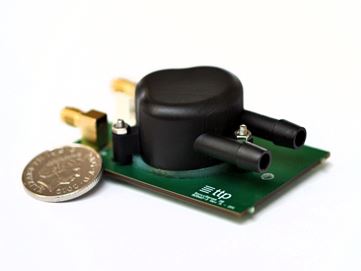Ultrasonic sensor is low-cost solution for analysing gas composition
31 January 2014
Cambridge technology company TTP has developed a miniature gas sensor that radically cuts costs, size and power consumption compared to current technology. The new ultrasonic sensor uses patent-pending TTP technology to precisely measure the speed of sound in a gas to determine its composition.
The ultrasonic sensor draws on TTP’s expertise in nonlinear acoustics and piezoelectric devices. Once the speed of sound through the gas is measured, thermal compensation is applied before the composition of a binary gas mixture is calculated. Additional bulk gas properties such as density can also be determined using the same sensor architecture to enable more complex gas mixtures to be evaluated.
TTP has developed prototype sensors for their existing clients with a sensor diameter of only 24 mm and a depth of 18 mm — but it is expected that this dimension can be reduced to less than 5 mm. The sensor has a simple, robust design and low power consumption of around 10 mW — compared to over 1 W for some gas sensors. It is aimed at long-lifetime, battery powered applications with no in-field replacement or calibration required.

While current infrared gas sensing devices for carbon dioxide can cost over £240 and paramagnetic systems for oxygen around £120, TTP believes that its new SonicSense devices will cost between £3 and £6 each in volume production. Potential medical applications include respiratory monitoring, capnography, anaesthesia and COPD monitoring.
“Many medical or industrial gases are expensive or difficult to measure directly,” said Andrew Baker-Campbell, one of the inventors of this technology at TTP. “SonicSense opens up the possibility of replacing high-cost sensors in existing products or enabling exciting new solutions for applications where sensing gas is currently prohibitively expensive.
As well as medical applications we are looking at a wide range of use-cases for gas safety and industrial monitoring and control, and are keen to work with development partners who see an opportunity to harness and commercialise low-cost sensing.”